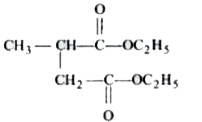In the given reaction
CH3−O∣∣C−C2H5X−−→CH3−CH2−C2H5
'X' will be
LiAIH4
NaBH4
BCl3SnH
NH2−NH2/OH−, glycol
The correct Answer is:D
To solve the problem, we need to identify the reagent 'X' that converts the compound CH3C(=O)C2H5 (a ketone) into CH3CH2C2H5 (an alkane).
1. Identify the Reactant and Product:
- The reactant is CH3C(=O)C2H5, which is a ketone (specifically, 3-pentanone).
- The product is CH3CH2C2H5, which is an alkane (specifically, pentane).
2. Understand the Reaction Type:
- The transformation from a ketone to an alkane indicates a reduction reaction. In organic chemistry, this type of reaction typically involves the removal of the carbonyl group (C=O) and the addition of hydrogen.
3. Evaluate the Given Options:
- Option 1: LiAlH4 - This is a strong reducing agent that can convert ketones to alcohols, not directly to alkanes.
- Option 2: NaBH4 - Similar to LiAlH4, this is also a reducing agent that converts ketones to alcohols.
- Option 3: BCl3/SnH - This is not commonly used for reducing ketones to alkanes.
- Option 4: NH2NH2 in presence of OH− and glycol - This is known as the Wolff-Kishner reduction, which specifically reduces ketones to alkanes.
4. Conclusion:
- The correct reagent 'X' that will convert the ketone CH3C(=O)C2H5 to the alkane CH3CH2C2H5 is NH2NH2 (hydrazine) in the presence of OH− and glycol.
Final Answer:
- X will be NH2NH2 in presence of OH− and glycol.
- The reactant is CH3C(=O)C2H5, which is a ketone (specifically, 3-pentanone).
- The product is CH3CH2C2H5, which is an alkane (specifically, pentane).
- The transformation from a ketone to an alkane indicates a reduction reaction. In organic chemistry, this type of reaction typically involves the removal of the carbonyl group (C=O) and the addition of hydrogen.
- Option 1: LiAlH4 - This is a strong reducing agent that can convert ketones to alcohols, not directly to alkanes.
- Option 2: NaBH4 - Similar to LiAlH4, this is also a reducing agent that converts ketones to alcohols.
- Option 3: BCl3/SnH - This is not commonly used for reducing ketones to alkanes.
- Option 4: NH2NH2 in presence of OH− and glycol - This is known as the Wolff-Kishner reduction, which specifically reduces ketones to alkanes.
- The correct reagent 'X' that will convert the ketone CH3C(=O)C2H5 to the alkane CH3CH2C2H5 is NH2NH2 (hydrazine) in the presence of OH− and glycol.
- X will be NH2NH2 in presence of OH− and glycol.
Topper's Solved these Questions
- HYDROCARBONSBOOK - AAKASH INSTITUTE ENGLISHCHAPTER - HYDROCARBONSEXERCISE - SECTION-C OBJECTIVE TYPE QUESTIONS (MORE THAN ONE OPTIONS ARE CORRECT)
12 Videos
- HYDROCARBONSBOOK - AAKASH INSTITUTE ENGLISHCHAPTER - HYDROCARBONSEXERCISE - SECTION-D LINKED COMPREHENSION TYPE QUESTIONS
7 Videos
- HYDROCARBONSBOOK - AAKASH INSTITUTE ENGLISHCHAPTER - HYDROCARBONSEXERCISE - ASSIGNMENT SECTION-A COMPETITION LEVEL DIFFER BY
50 Videos
- HALOALKANES AND HALOARENES BOOK - AAKASH INSTITUTE ENGLISHCHAPTER - HALOALKANES AND HALOARENES EXERCISE - ASSIGNMENT SECTION -D
15 Videos
- HYDROGENBOOK - AAKASH INSTITUTE ENGLISHCHAPTER - HYDROGENEXERCISE - ASSIGNMENT (SECTION - D) (Assertion-Reason Type question)
15 Videos
Similar Questions
Knowledge Check
What is the given reaction known as?
CH3−O∣∣C−CH3C6H5CO3H−−−−−−→CH3−O∣∣C−O−CH3ABaeyer-villiger oxidationBOppenauer oxidationCPeriodate oxidateDPeroxide oxidationFind the product of following reaction
2CH3CH2−O∣∣C−OC2H5C2H5ϴO−−−−−−→H⊕3O(X)
X will beACH3−CH2−O∣∣C−CH∣CH3−O∣∣C−OC2H5BCH3−CH2−O∣∣C−CH∣∣CH3−O∣∣C−OC2H5C2CH3CH2−O∣∣C−OHD
In the given reaction C6H5−O∣∣C−CH3(i)C2H8MgBr−−−−−−−−→(ii)H2O/H+(X) X will be
View SolutionIn the given reaction,
OHC−(CH2)3−O∣∣C−CH3ΘOH/Δ−−−−→(X)'
the major product 'X' will be
View SolutionWrite the IUPAC names of the following compounds
(i) CH3−CH2−O∣∣C−CH2−O∣∣C−CH3
(ii) CH3−O∣∣C−CH2−CH2−CH2−CH2−COOH
(iii) CH3−CH∣C2H5−CH∣C2H5−CH3
View SolutionWhich of the following can give iodoform test?
(I) CH3−O∣∣C−CH2−O∣∣C−CH3
(II) C6H5−CH2−O∣∣C−CH3
(III) CH3−CHO
(IV) C6H5−O∣∣C−CH3
View SolutionWrite the IUPAC name of the following compound: H3C−O∣∣C−CH2−Cl∣CH−CH3
View SolutionThe IUPAC name of the compound given below is :
H3C−CH2−O∣∣C−CH2−CH2−O∣∣C−OCH3
View Solution
